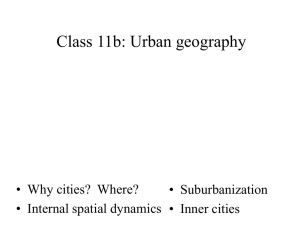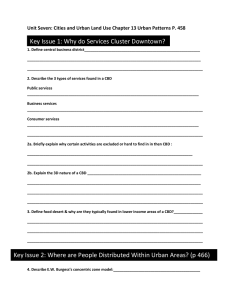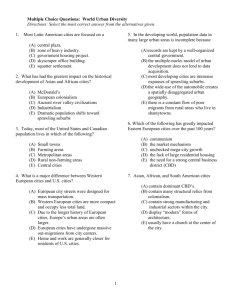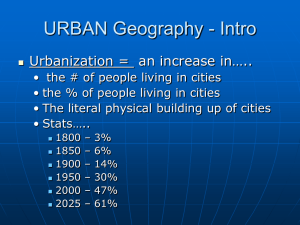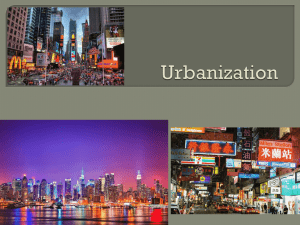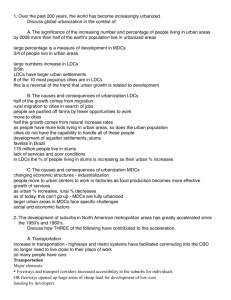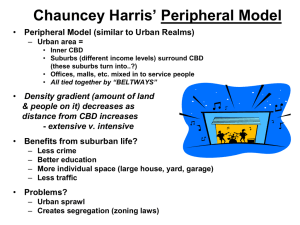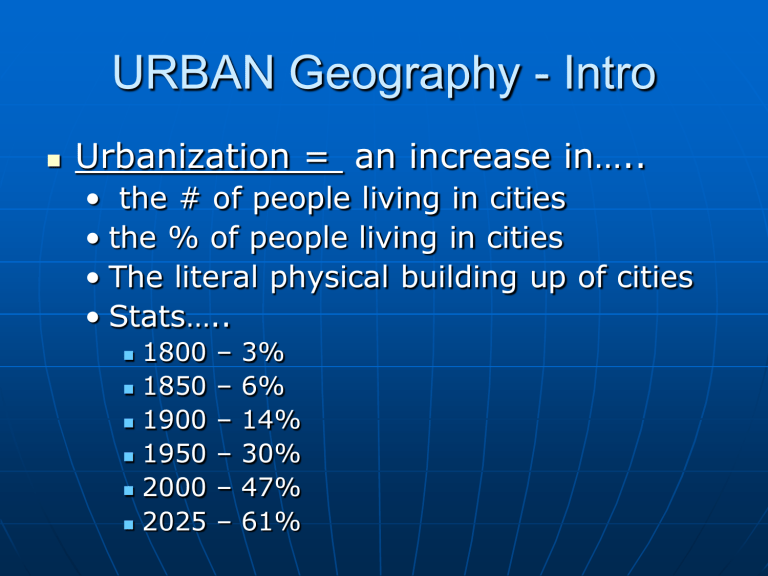
URBAN Geography - Intro Urbanization = an increase in….. • the # of people living in cities • the % of people living in cities • The literal physical building up of cities • Stats….. 1800 1850 1900 1950 2000 2025 – – – – – – 3% 6% 14% 30% 47% 61% Urbanization – Intro – cont’d Urbanization is a measure of development (abundant AG tech, people leave rural areas for cities for work and services) • MDCs - @75% urban • LDCs - @40 % urban • BUT LDCs contain most of world’s largest cities (6 of top 10 in LDCs) • i.e. MDCs have highest levels of urbanization, LDCs have highest rates Urbanization – Intro – cont’d LDCs = mega cities: rapid pop growth and migration to cities has caused explosion of urban growth in LDCs. LDCs cannot support booming growth. Mega cities plagued by chaotic, unplanned growth…no jobs, poor infrastructure, inadequate housing, urban squalor, horrible pollution, poverty, squatter settlements Mega Cities – MX City and Mumbai, India Urbanization – Intro – cont’d MDCs = world cities – worldwide centers of econ, pol, cultural activity and influence. • Top tier = econ and cultural powerhouses…NYC, London, Tokyo • Second tier…. Govn’t Seats – DC, Moscow, Paris Pop Culture – LA, Mumbai Industrial Centers – MX City, Sao Paulo World Cities – Tokyo and London Defining Urban Settlements Where does “the city” begin?? Social distinctions betwn urban/rural…..Cities have • Lots of people most of whom are anonymous • High pop density • Job specialization • Social heterogeneity (diverse) Physical Distinction Betwn Urban and Rural City Center: legal boundary (i.e. DC proper). Independent and self governing unit (city officials, taxes, providing services, etc.) Urbanized Area: central city + surrounding suburbs (i.e. Arlington, Herndon = urbanized area of DC) Physical Distinction Betwn Urban and Rural Metropolitan Statistical Area (MSA): the functional area/region of a city – i.e.. its zone of influence Megalopolis: When MSAs overlap and create one continuous highly urbanized complex. Ex: from Boston to DC = Boswash Corridor Boswash Corridor - Megalopolis Central Business District CBD CBD = city center/historic downtown within the central city • CBD is compact – less than 1% of urban area but has large %% of shops, offices, public institutions, sports complexes, etc. • Historically services were in CDB but today have moved to suburbs CBD • Land value in CBD is extremely high • Demand for space leads to sky scrapers…since cannot build out you build up – unique skylines • Little manufacturing in CBD (not enough land) • Few people actually live in CBD (rent too high) Spatial Organization of Urban Areas People and activities in cities are not distributed randomly – they concentrate in particular places depending on their social characteristics 3 prominent models explain city organization….. Concentric Zone Model • Dev in 1923 by E.W. Burgess • Based on Chicago • Concentric rings of dev coming outward from the core (CBD) • Each ring = diff types of dev and econ activities • Land value decreases as you move out • Model based on process of invasion and succession – newest immigrants move into old housing near city center and push earlier groups outward Concentric Zone Model Zones… • 1.) CBD – non residential activities • 2.) Transition Zone – industry and poor quality housing (newest immigrants) • Industrial Workers’ houses – working class • Middle Class/better homes • Commuter Zone – high class residencies Sector Model Dev in 1933 by Homer Hoyt Also based on Chicago Says city dev in sectors not rings. Sectors radiate out from CBD like spokes on a wheel Activities expand in wedges Seems to work better for Latin American cities (MX City fits sector model) Hoyt Sector Model Multiple Nuclei Model 1945 – Harris and Ullman City doesn’t have just one central core but many nodes of business and cultural activity Los Angeles = classic example – no real downtown but instead many independent nodes of high land value and business activity – Santa Monica, Pasadena, Hollywood, etc. LA – Multiple Nuclei Multiple Nuclei Model This is a better model for cities built mostly after WW II and post auto dependent. Older cites built b/f auto are more compact w/ real downtown (CBD). Newer cities have more sprawl and multiple nuclei. *** NO city matches any one model perfectly City Models To use models for data mush have good data – Census Tracts – cities divided into about 5,000 resident census tract sections (often follow neighborhood lines). Every 10 yrs gather info about people in that tract (race, age, median income, occupation, level of education, etc.) Criticisms of Models 1.) Models too simplistic and fail to consider all of the varied and complicated reasons that cause people to select a certain location 2.) all 3 models created in U.S. between world wars – are they relevant to other countries and are they still relevant today? Inner City Problems In U.S. cities greatest contrast is betwn suburbs and inner city Ghettoization: process of inner city decay Problems…….. Inner City Problems Old, poor quality housing • Filtering – subdividing big old homes into several apartments and use for low income rent • Redlining: banks draw lines on map and refuse to loan $$ within • Public housing projects (subsidized – pay 30% of income in rent) –run by govnt…poorly maintained, drugs, crime, violence, gangs, high density, culture of poverty, etc. Scattered public housing – pros/cons? Inner City Problems Chicago housing projects…. government subsidized housing Inner City Problems 2.) Social Problems • Permanent underclass – trapped in perpetual cycle (unemployment, teen pregnancy, drugs, gangs, single parents, welfare, high school dropout, etc. Can you get out? (There Are No Children Here) • Racial and ethnic segregation – disproportionate minority representation Inner City Problems – cont’d 3.) Economic Problems • Often lacks adequate public services and lacks tax base to pay for them (i.e. schools, roads, etc.) • Annexation – legally adding land area to a city’s boundaries. Most suburbs do not want to be annexed in and rarely happens anymore Inner Cities – Urban Renewal Revitalization – new attempts to fix up downtown…buy poor houses, build new, shopping, cultural attractions…try to b ring in young, single professionals Gentrification: process where inner city neighborhoods turn into expensive/fashionable urban districts (squeezes out low income residents) Problems of Suburbs Rapid growth of Suburbs in 2nd half of 20th C (i.e. auto, GI Bill, mass production of housing) 1950: 20% in suburbs 40% in central city 40% small towns/rural areas 2000: 50% in suburbs 30% in central city 20% small towns/rural areas Suburbs – cont’d Counter urbanization – net migration from urban to rural areas (happening in some parts of N. American and W. Eur for first time). More people moving to rural areas than are leaving. • Exurbanite: people who leave city to move to suburbs or rural area Suburbs – cont’d Urban Sprawl: goes hand and hand w/ transportation…HUGE sprawl after the automobile • Older cities like NYC, pre-auto – densely packed, narrow streets, lots of high rise • Newer cities like LA, Atlanta – post auto are sprawling areas with clogged superhighways, multiple nuclei, and far flung suburbs that operate independently of each other Suburbs – cont’d Suburbanization – is a process NOT a place • Began after WW II, mass phenomenon by end of 20th C • GI Bill, mass auto ownership, and mass production of housing drives suburbanization Suburban Sprawl – cookie cutter neighborhoods Suburbs – cont’d Cons of Suburbs…. • Land hungry process – vanishing green, encroaching on good AG land • Lose unique sense of place – all are cookie cutter alike (strip malls, chain stores) • Auto dependent and fuel consumption (pollution) • Rush hour commute Suburban Commute Suburbia - Homogenization Suburbs – cont’d Suburban growth comes at expense of inner city • Erosion of tax base • Segregation – poor, elderly, singles, minorities in cities. Young families, white, educated wealthier move to suburbs. (Suburbs replace vertical seg) • Spatial Segregation – rarely go to other’s place • Zoning also fuels segregation Suburbs – cont’d Edge Cities: urban sprawl sometimes takes the form of edge cities • Located on outskirts of larger cities and come to serve many of same functions as large city • Often located off a beltway surrounding main city • Classic ex: Tyson’s Corner Smart Growth/Urban Growth Boundaries Limit sprawl through long range planning and efficient transportation Promote compact and contiguous dev (i.e. fill in the gaps) Protect farmland, recreation, wildlife Set growth boundaries In U.S. – MD, OR, NJ, RI, and WA lead the way w/ smart growth Central Place Theory Theory developed by Walter Christaller in 1930s in Germany. Looks at relationship betwn cities and surrounding communities based on people’s demands for goods and services • Central Place: place (big city) people travel to make purchases • Market Area: areas people travel from for purchases (i.e. the functional region of the central place)….where do you go to buy groceries, a car, medical treatment, etc.? Central Place Visual Central Place Theory Large cities are the econ hubs for their region b/c they provide a great variety of goods and services not available in smaller communities Hinterlands: smaller towns in periphery of big city/central place. People from hinterland often travel to central place for big city amenities (i.e. sports teams, cultural events, restaurants, etc.). Small towns in hinterland contain fewer goods and services than central place. Central Place Theory Size of Market Area….assume you wanted to open a new store, how do you determine 1.) if it will be profitable and 2.) where the best location is within the market?? The answer to these questions varies for all services based on range and threshold. Central Place Theory Range: maximum distance people willing to travel for your service • Often expressed in time not distance • Short distances for groceries, long for bball game. Short distance for gas, long distance for medical treatment • Must be modified if competing locations provide same service Central Place Theory Threshold: minimum number of people needed to support a service • How many customers do you need to make a profit? • Potential customers in a given areas depend on the product (i.e. not a high demand for a roller skate rink in a retirement community) Central Place Theory Low order central place functions: have small range and threshold. • Services obtained on regular basis • Requires only a small market to be profitable • People unwilling to travel far to obtain it • Ex: gas, groceries, movies, etc. Central Place Theory High order central place function: large range and large threshold • Is required less frequently • Requires a large market area (lots of customers) to be profitable • People willing to travel further to obtain it • Ex: pro ball team, special medical services, museums, concerts, etc. Central Place Theory The Gravity Model can predict optimal location for service • Directly related to # of people in the area • Inversely related to distance people must travel to access it Central Place Theory Therefore…… • Small settlements are limited to low order functions (w/ small ranges and thresholds and market areas) b/c too few people live here • Higher order functions are more likely to be in big cities (central places) w/ enough people to support the larger range, threshold, and market area Rank Size Rule Ranking settlements from largest to smallest in a country often produces a pattern Rank Size Rule: • The country’s nth largest city is 1/n the size of the population of the largest • i.e. the 3rd largest city is 1/3 the size of the largest Rank Size Rule When plotted rank size distribution is a fairly straight line (true for U.S.) Works better for MDC’s (LDC’s not enough wealth in society to pay for full variety of services in other cities) If graph is not fairly straight line it does not fit rank size rule Rank Size Rule Primate City: largest city has more than 2X the second largest city (i.e. big city = primate city) • Ex: Paris is primate city – has 11 mill and Lyon (next biggest) has 2 mill (rank size rule says it should have 5.5 mill) • Ex: London is primate city – has 11 mill and Birmingham has 3 mill • Look at Google images – rank size rule Bid Rent Theory Land closest to CDB is most expensive Pop density greatest closest to the CBD Affects land use Economic Base A city’s economic base includes its basic and nonbasic industries… • Basic industries: export primarily to customers outside the settlement (ex: Dell computer plant, BMW plant) • Nonbasic industries: services whose customers live within the same community (public schools, restaurant, movie theater) Economic Base A city’s unique collection of basic industries is its primary econ base. Exporting basic industries brings $$$ to the local econ and stimulates provisions for more nonbasic consumer services for the community. I.e. a new plant brings in workers, families and stimulates growth…new neighborhoods, schools, shopping centers, etc. Economic Base How to figure a city’s basic industries? • Compute % of workers in a particular industry in a city • Compare to % of all workers in the country employed in that industry • If % is higher in the city than it is a basic industry for that city Urban Planners Urban planners consider people’s perceptions, feelings, behaviors, patterns, etc. to make decisions about future urban growth. They always plan way ahead and anticipate . Planners make decisions @ highway locations, zoning, future transportation networks, bridges and overpasses, etc. Urban Planners Planners are aware of 5 general rules of people’s travel • We make many more short trips than long ones • We worry little about distance when close to home, but when a trip requires travel further from home distance becomes an important factor in deciding whether or not to go Urban Planners • For adults, the longest trips tend to be work related • Transportation limits some spatial behavior • People avoid perceived hazards, whether or not those hazards pose a real threat
